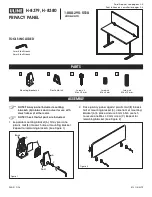
1
Getting Familiar with Your TriPlus RSH
MHE Station
Thermo Scientific
TriPlus RSH User Guide
49
Naming Convention for MHE Station
MHE Adapter
— The MHE Adapter, equipped with a built-in needle, is used as the tool to
release the pressure from the vial.
The MHE Adapter is also equipped with a vent outlet connector for connecting a vent line. In
cases toxic gases are released from the vial, the venting line can be positioned into a
neutralizing agent or to a fume hood to protect the operator and the environment.
MHE Needle
— The MHE Needle is a dedicated needle used for the MHE Adapter only.
Length: 46 mm, Gauge 22, Point style 5 (side hole needle tip).
MHE Adapter Holder
— Parks the MHE Adapter in between the cycles, or in standby
position.
Principles of Multiple Headspace Extraction (MHE)
This section provides a brief description of the MHE principle.
Introduction
The multiple headspace technique is used in instances where interfering matrices interact with
the analyte, such as by partial adsorption, or if a solid analyte contains low concentrations of
moisture. Whenever it is impossible to prepare the calibration standard using an identical
matrix to that of the actual sample, single point calibration using the static headspace
technique will fail.
The term multiple headspace extraction (MHE) is partially self-descriptive. To determine the
quantity of an analyte, sampling is carried out by repeated extraction of gas from the same vial
above a sample solution containing the analyte (known as the headspace). The method thus
approaches continuous gas extraction but is carried out in a stepwise fashion.
In concept, the procedure is analogous to the multiple extraction of a sample from a simple
elution column, where each passage of eluate through the column reduces the amount of
analyte contained in a subsequent passage. The peak area from any given extraction will be
smaller than that of the previous extraction step. The sum of the peaks will be proportional to
the total content of the analyte.
A quantitative determination of the total amount of analyte present in a sample depends on
the relationship between peak area and the amount of analyte. The sum of the amounts of
analyte that are removed will eventually equal the total amount of analyte in the original
sample if the extractions are continued to infinity.
Theoretically, summing up the peaks obtained from an infinite number of column extractions
would allow the calculation of the absolute amount of analyte in a sample. In practice, it is
sufficient to carry out a limited number of extractions, permitting a determination of the
underlying exponential relationship between the measured area and the number of
extractions, in turn allowing for the determination of the total amount of analyte in the
sample.
Summary of Contents for TriPlus RSH
Page 4: ......
Page 14: ......
Page 206: ......
Page 252: ...5 Service Menu Item Teach Home Position 226 TriPlus RSH User Guide Thermo Scientific ...
Page 258: ......
















































